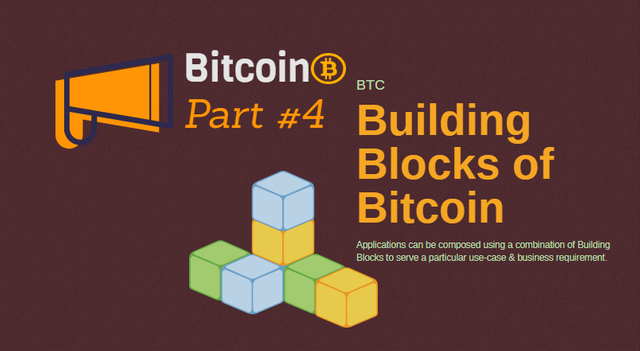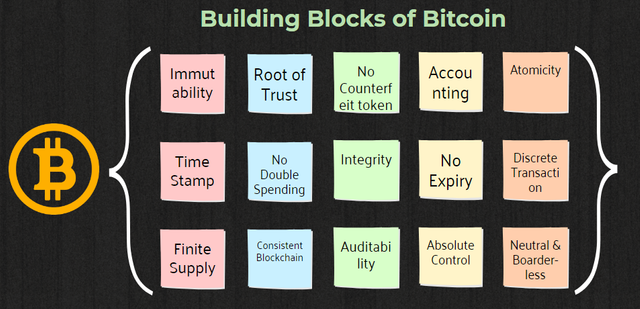Bitcoin: Part 4: Building Blocks of Bitcoin


In the ongoing #steemcryptochallenge, I have already published Bitcoin: Part 1, Part 2, Part 3. Today I will detail Part 4.
This publication will cover what are the building blocks of Bitcoin and how they are required to serve a particular business use-case.

What properties or the inherent characteristics make Bitcoin dear to me? (Building Blocks)
Immutability
The Blocks are produced in Bitcoin Blockchain through Proof-of-Work Mechanism, The Blocks in itself are a chain of blocks as each block contains the hash of its own as well as the previous block. So "an ordered Blockchain". Further, it is append-only. You can only add a block. You can not erase a Block. Therefore the data that is recorded in a Blockchain is immutable.
Root of Trust
The security architecture of Bitcoin relies on the consensus, public ledger, Root of Trust. The Root of Trust is the genesis Block and the fully validated Blockchain. So any Layer 1 application should explicitly vest trust on a validated Blockchain and the Genesis Block.
No room to create a counterfeit token
The counterfeit token is impossible in Blockchain as the protocol will prevent any such attempt. If at all someone tries to counterfeit Bitcoin, the Blockchain will branch, and by principles, the longest chain is the valid chain. The valid transaction will always have the Blockchain attached to it.
Further, the protocol tracks every transaction, every single Bitcoin that is minted through mining as Block reward.
Accounting
It is impossible to destroy or create value in Bitcoin. Simple because the output can not be greater than the input.
If you initiate a Transaction, then INPUT= OUTPUT+ NETWORK FEES. Network Fee is paid to the miners.
So Output can not be greater than the input. Put simply you can not create or destroy value through a Bitcoin transaction.
Atomicity
A Bitcoin transaction is either confirmed(valid) or not. There is no other state for a Bitcoin transaction; thereby making a transaction atomic. In technological terms, we can say either a Bitcoin transaction can be mined or can not be mined.
Time-stamp
Time-stamping in Bitcoin Blockchain guarantees that the data that is included in the Block is not previously created, which means unspent-before. Further, the consensus rule in Bitcoin Blockchain does not recognize the time-stamp of a block too far from the past, that is why each timestamp includes the immediate previous timestamp.
No Double-spending
An ordered Blockchain together with timestamping fundamentally guarantees no amount can be spent twice.

Integrity
One can not modify a transaction without invalidating the signatures. One can sign a Bitcoin transaction with the private key. One can verify a transaction with a Public key & signature. The reverse way is not possible by the Bitcoin protocol.
No Expiry
There is no such thing as the expiry date in a Bitcoin transaction. It is valid for today, tomorrow and the future as long as the consensus remains in place and does not change. The only condition for a No-Expiry Transaction is Unspent Input.
Discrete Transaction
You can not divide a Bitcoin Transaction Output into parts. Either you can spend it fully or it will remain as unspent (full).
100% Up time
There is no such downtime for Blockchain. Being the decentralized nature, a Blockchain always ensures 100% Up Time.
Finite Supply
The maximum total supply of Bitcoin is 21 Million only. The Block Reward halves every 210,000 Blocks(approx 4 years).
Consistent Blockchain
The data that is recorded in Blockchain can not be reorganized, even with the disagreement among the miners. Even if they split it is practically impossible to alter and reorganize the data that is already recorded, for that, the kind of computing effort and energy required is practically infeasible. The only way in case of divided opinion and consensus is that one group can fork the chain.
Auditability
Starting from the genesis chain, the Blockchain is an ordered chain, and un-broken chain and is a public ledger that is visible to all. It is transparent. It can be audited by anyone.
Authorization & Absolute Control
The legitimate owner of the Bitcoin is the one who owns the key. The private keys ensure absolute control of the fund. The script of the Bitcoin always requires to sign the transaction with the Private key and then the public key and the signatures are verified, validated by the miners through the consensus mechanism called PoW.
Boarder-less & Neutral
Anyone can sign a transaction in Bitcoin network regardless of geography, country, origin, ethnicity. It is borderless. It is decentralized, it is permission-less. It does not involve a third party.

These properties of Bitcoin are in fact, the building blocks to create applications on the top of Blockchain. One can customize and compose a Proof-of-concept application using these features or a combination of features. Whenever an application is built on layer 1, the trust is always rooted in Genesis Block and the valid Blockchain.
Example,

For a digital Notay, you need to record a document, to prove that it exists from that particular time(Time-stamping). You need to make sure that the data should not be altered or forged(Immutability).
In a similar way, you can create many other applications, such as payment channels, identity checks, medical records, lightning networks, and many others.
Thank you.

Cc:-
@steemitblog
@steemcurator01
@steemcurator02

Congratulations you are one of the winners of the Steem Crypto Challenge Month...
Thank you for taking part
The Steemit Team
Thank you so much.
Steem on.
For something it is the leading cryptocurrency